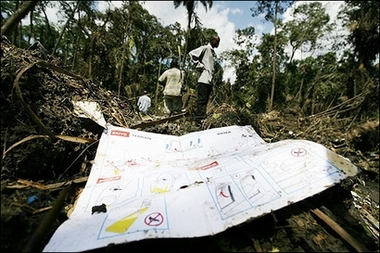Cameroon plane probe focuses on pilot
(AP)Updated: 2007-05-10 19:38
DOUALA, Cameroon - Officials investigating the crash of a Kenya Airways flight will focus initially on why the pilot took off in a thunderstorm, an official familiar with the probe said Thursday.
 A safety notice lies on the ground, 07 May 2007, on the site where a Kenya Airline Boeing 737-800 crashed near the village of Mbanga Pongo in the Douala area. Cameroon on Wednesday defended the delay in locating the crash site of a Kenya Airways jet, saying search operations were based on satellite information from France which were wide off the mark.[AFP] |
Flight KQ507 dove into a swamp seconds after takeoff Saturday, killing all 114 people on board the Boeing 737-800.
The official said a Royal Air Maroc jetliner that was next in line to take off from the Cameroonian airport waited 45 minutes after the departure of the Kenya Airways flight.
"We want to know why did other planes wait for the storm to pass and not him. That's the question," said the Cameroonian official. He would not be named because of the sensitivity of the subject.
The flight was already delayed an hour because of a storm. Douala airport's weather report had predicted the storm would last another hour.
Aviation regulations allow cockpit crews to take off in bad weather unless the local flight control takes extraordinary measures, such as temporarily closing down the airport.
Jim Hall, a former chairman of the National Transportation Safety Board, sent seven experts to help with the investigation. He said it was vital to determine exactly what went wrong because the accident involved thee most modern version of Boeing's family of short- to medium-distance jets. More than 5,000 Boeing 737-800s are in use worldwide.
"The 737-800 is the latest version of the world's most popular airliner," he said in a telephone interview from Washington, D.C. "Any malfunction could have very wide implications."
Two Boeing representatives were due to join the investigators, said Lonnie Kelley, a spokesman for the U.S. Embassy in Cameroon.
The flight data recorder has been recovered but still needs to be decoded. The cockpit voice recorder has not yet been found.
The Cameroonian official said preliminary investigations indicated the plane had just raised its landing gear after takeoff and may have partially retracted its wing flaps.
He said speculation centered on the possibility that the plane flew into a storm cloud and was maneuvering when a strong gust of wind caught the Boeing and flipped it over, especially if it was banking steeply to one side to avoid a storm cell.
Another possibility is that it experienced engine failure, the official said.
Dale Schultheis, a former pilot for Cameroon Airlines, said air traffic control and navigation standards in the area conformed to regional standards.
"Flight planning was done by Cameroon Airlines and was generally quite good, as was the weather reporting," said Schultheis, who now lives in Florida.
Douala airport is not equipped with weather radar, but virtually all civilian airliners carry it to avoid flying into thunderheads - the violent cumulonimbus clouds whose severe updrafts and downdrafts can cause structural damage.
The 737-800 crashed nose-first in a swamp less than a minute's flying time from the end of the runway. But the wreckage was not found until more than 40 hours after the crash.
|
||
|
||
|
|